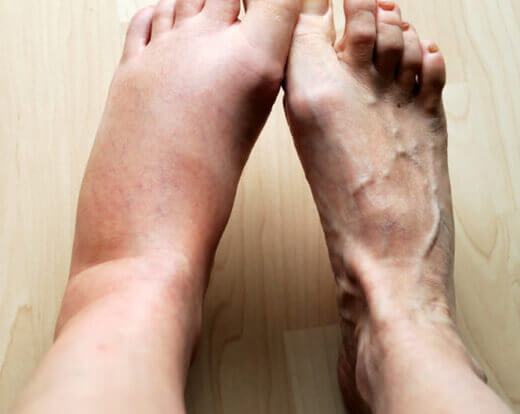Lymphedema is a swelling of a body part, most often an extremity, resulting from an accumulation of fluids, in such proportion to be palpable and visible. Lymphedema occurs when the lymph vascular system is not able to fill its function of reabsorpbtion and transport of the protein and lymph load. Lymphedema occurs whenever lymphatic vessels are absent, underdeveloped or obstructed.
The condition most often causes embarrassment and causes decreased mobility, discomfort and often repeated episodes of infection, cellulitis and lymphangitis. This can lead to general depression and a general worsening of the patient’s life and health. Fungal infections can be very frequent and these place a greater load on the lymphatics. Severe cases are associated with thickening of the skin, hardening of the limb (fibrosis), leakage of lymph and massive swelling (elephantiasis).
How Does Lymphedema Occur?
A stagnation of protein develops in the tissue. This raises the colloid osmotic pressure and a protein rich edema arises. There are more protein rich fluids in the tissue than can be transported and the proteins attract water by osmosis. The affected area becomes swollen, enlarged and uncomfortable. This swelling decreases oxygenation of the tissues, interferes with their normal functioning and makes them heal more slowly than normal. The excess protein also serves as a stimulus from chronic infection and can result in formation of excess fibrous tissue. Lymphedema is a chronic and if left untreated, progressive condition. It can however, be brought under control by appropriate treatment and care.
Lymphedema may be due to a primary (congenital or genetic) cause or of a secondary cause (caused by a known condition), including removal of the lymph nodes or trauma.
Types of Lymphedema
Primary Lymphedema
Primary Lymphedema is that which has no known cause.
- Milroy’s disease is a familial (genetically caused) lymphedema which is present at birth.
- Meige’s disease is similar, but appears no later than puberty.
- Lymphedema Praecox is the most common form of primary lymphedema. This begins in adolescence. It is predominantly females who suffer from this condition. Seventy five percent of primary lymphedema is praecox.
- Lymphedema Tarda is identical to Lymphedema praecox but occurs after the patient is 35 years old. Both praecox and tarda almost always involve just the legs.
The pathological mechanisms which cause primary lymphedema are an absence of lymphatics (aplasia), inadequate lymphatic drainage, too few lymphatics or too few nodes, or lymphatics which are hugely dilated.
Secondary Lymphedema
Secondary lymphedema is an acquired condition resulting from loss or obstruction or previously normal lymphatic channels. The most common cause of secondary lymphedema is due to removal of the lymph nodes, as part of surgery for malignancies. The lymph pathways can be interrupted by radiation, surgery, injury or blockage with parasites.
– Symptoms of Lymphedema
Patients experience swelling in the affected limb and may experience one or all of the following symptoms: tingling, tightness, numbness, slight pain, feeling of fullness, heaviness, cramps and a burning sensation in limb. There may be range of motion limitations and temperature differences between the limbs. We help to effectively reduce the symptoms of lymphedema and help you to participate in your daily activities once again.
– Stages of Lymphedema
Stage 0, also known as latent stage or subclinical stage of lymphedema
At this stage the patient is at risk of developing lymphedema, however there is no swelling present, even though the lymph system has been disturbed by sugery or radiation. In stage 0 patients may experience early symptoms, such as the feeling of numbness, tingling or fullness in a limb, which is often accompanied by low-grade discomfort
If we treat at this stage the symptoms can be easily controlled using off the shelf compression garments.
If we can consult with you soon after surgery, we can educate you and reduce the risk of lymphedema
Stage I, also known as pitting or reversible stage
The affected arms or legs become visibly swollen, as a protein-rich fluid starts to accumulate in the tissues.
Upon elevation, the swelling reduces.
There is a pitting edema and the limb may appear normal the next morning.
Stage II, also known as spontaneously-irreversible stage
There is an increase in the swelling and a change in the tissues
The skin becomes harder (fibrotic) and there are skin changes.
Upon elevation, the limb does not reduce.
Pressure against the limb produces only a slight indentation or in indentation at all.
Stage two lymphedema can be reversed with intense therapy.
Stage III, also known as lymphostatic elephantiasis
In this stage, there is a buildup of fluid in the tissues and the swelling increases.
Pressure on the skin does not produce any pitting and there are skin changes, as skin begins to breakdown.
Normal elasticity is lost and the skin hangs in folds.
The person is very likely to become infected as the swelling becomes a perfect culture for bacteria to breed. There is a risk of infection and subsequent recurrent infections (cellulitis)
Untreated lymphedema can lead into a decrease or loss of functioning of the affected extremity, skin breakdown and sometimes irreversible complications.
Treatment option lymphedema
Complex decongestive therapy – link to treatment options
Nutritional counseling
Aromatherapy
Fat Disorders – Rare Adipose Disorders – Lipedema and Dercums

